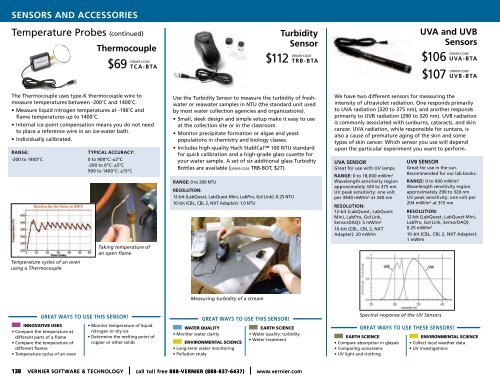Download - Amazon Web Services
Download - Amazon Web Services
Download - Amazon Web Services
You also want an ePaper? Increase the reach of your titles
YUMPU automatically turns print PDFs into web optimized ePapers that Google loves.
sensors and accessories<br />
temperature Probes (continued)<br />
thermocouple<br />
the thermocouple uses type-K thermocouple wire to<br />
measure temperatures between -200˚c and 1400˚c.<br />
• Measure liquid nitrogen temperatures at -196˚c and<br />
fl ame temperatures up to 1400˚C.<br />
• internal ice-point compensation means you do not need<br />
to place a reference wire in an ice-water bath.<br />
• individually calibrated.<br />
range:<br />
-200 to 1400°c<br />
Temperature cycles of an oven<br />
using a Thermocouple<br />
INNOVATIVE USES<br />
• Compare the temperature at<br />
different parts of a fl ame<br />
• Compare the temperature of<br />
different fl ames<br />
• Temperature cycles of an oven<br />
$69<br />
tyPical accuracy:<br />
0 to 900°c: ±2°c<br />
-200 to 0°c: ±5°c<br />
900 to 1400°c: ±15°c<br />
great Ways to use tHis sensor!<br />
orDer coDe<br />
tca-bta<br />
Taking temperature of<br />
an open flame<br />
• Monitor temperature of liquid<br />
nitrogen or dry ice<br />
• Determine the melting point of<br />
copper or other solids<br />
range: 0 to 200 ntU<br />
resolution:<br />
12-bit (labQuest, labQuest Mini, labPro, go!link): 0.25 ntU<br />
10-bit (cBl, cBl 2, nXt adapter): 1.0 ntU<br />
turbidity<br />
sensor<br />
Use the turbidity Sensor to measure the turbidity of freshwater<br />
or seawater samples in ntU (the standard unit used<br />
by most water collection agencies and organizations).<br />
• Small, sleek design and simple setup make it easy to use<br />
at the collection site or in the classroom.<br />
• Monitor precipitate formation or algae and yeast<br />
populations in chemistry and biology classes.<br />
• includes high-quality hach Stablcal 100 ntU standard<br />
for quick calibration and a high-grade glass cuvette for<br />
your water sample. a set of six additional glass turbidity<br />
Bottles are available (orDer coDe trB-Bot, $27).<br />
Measuring turbidity of a stream<br />
WATER QUALITY<br />
• Monitor water clarity<br />
great Ways to use tHis sensor!<br />
ENVIRONMENTAL SCIENCE<br />
• Long-term water monitoring<br />
• Pollution study<br />
$112<br />
EARTH SCIENCE<br />
• Water quality: turbidity<br />
• Water treatment<br />
138 Vernier Software & technology- |- |- call toll free 888-vernier (888-837-6437)- |- |- www.vernier.com<br />
orDer coDe<br />
trb-bta<br />
uva sensor<br />
great for use with UV lamps.<br />
range: 0 to 18,000 mw/m 2<br />
wavelength sensitivity region<br />
approximately 320 to 375 nm<br />
UV peak sensitivity: one volt<br />
per 3940 mw/m 2 at 340 nm<br />
resolution:<br />
12-bit (labQuest, labQuest<br />
Mini, labPro, go!link,<br />
SensorDaQ): 5 mw/m 2<br />
10-bit (cBl, cBl 2, nXt<br />
adapter): 20 mw/m<br />
Spectral response of the UV Sensors<br />
uva and uvb<br />
sensors<br />
we have two different sensors for measuring the<br />
intensity of ultraviolet radiation. one responds primarily<br />
to UVa radiation (320 to 375 nm), and another responds<br />
primarily to UVB radiation (290 to 320 nm). UVB radiation<br />
is commonly associated with sunburns, cataracts, and skin<br />
cancer. UVa radiation, while responsible for suntans, is<br />
also a cause of premature aging of the skin and some<br />
types of skin cancer. which sensor you use will depend<br />
upon the particular experiment you want to perform.<br />
EARTH SCIENCE<br />
• Compare absorption in glasses<br />
• Comparing sunscreens<br />
• UV light and clothing<br />
$106<br />
$107<br />
uvb sensor<br />
great for use in the sun.<br />
recommended for our lab books.<br />
range: 0 to 900 mw/m2 wavelength sensitivity region<br />
approximately 290 to 320 nm<br />
UV peak sensitivity: one volt per<br />
204 mw/m2 at 315 nm<br />
resolution:<br />
12-bit (labQuest, labQuest Mini,<br />
labPro, go!link, SensorDaQ):<br />
0.25 mw/m 2<br />
10-bit (cBl, cBl 2, nXt adapter):<br />
1 mw/m<br />
great Ways to use tHese sensors!<br />
orDer coDe<br />
uva-bta<br />
orDer coDe<br />
uvb-bta<br />
ENVIRONMENTAL SCIENCE<br />
• Collect local weather data<br />
• UV investigations


